May 21, 2018
Special envoys from the US and Chinese presidents reach an agreement to halt further trade-war escalation.
A delegation led by Vice-Premier Liu He, President Xi Jinping’s special envoy, had “positive, pragmatic, constructive and fruitful” talks on Thursday and Friday with the US team headed by Treasury Secretary Steven Mnuchin, following their first round of talks in Beijing early this month.
Both sides have maintained for months that they were not embroiled in a trade war. This despite China imposing levies on $3 billion worth of US fruits, nuts, pork and wine to protest the Trump administration’s move to impose tariffs on steel and aluminium imported from China last month.
Prior to the summit between Mnuchin and Liu, the Trump administration had proposed levying 25 percent tariffs on 1,300 Chinese goods in aviation, technology and machinery sectors, which would add up to about $50 billion annually.
With the trade actions seemingly ramping up, the weekend’s deal with be viewed as a positive step in the right direction for all.
China and the United States issued a joint statement on Saturday vowing not to launch a trade war against each other. An agreement working out the specific trade issues of each sector is not forthcoming and according to both camps will be worked out ‘arduously’ over the next two years.
“Right now, we have agreed to put the tariffs on hold while we try to execute the framework,” Mnuchin said in a television interview.
In return for the halt on tariffs China would “significantly increase” purchases of US goods and services, and that this would “help support growth and employment in the United States”.
Reaction
Chinese media have hailed the meeting, calling the agreement a positive outcome. An editorial in the China Daily said that “that negotiation, rather than unilateral trade action, is the right way forward to address thorny bilateral issues.”
“It also demonstrates the vast potential of the world’s two largest economies, which are largely complementary in nature, to expand win-win cooperation instead of resorting to tit-for-tat trade retaliation as we have seen in the past months.”
In the United States, the agreement was also viewed positively.
Larry Kudlow, director of the National Economic Council, told reporters that China offered to narrow the trade gap by US$200 billion. “They are meeting many of our demands,” he said.
But economists say that the hard work was just beginning as negotiators look to address longstanding issues.
Patrick Cronin, senior director for the Asia-Pacific programme at the Centre for a New American Security, told the Straits Times that the deal was “harmonious… but far from clear whether this will address core concerns that prompted the threat of a trade war to begin with”.


